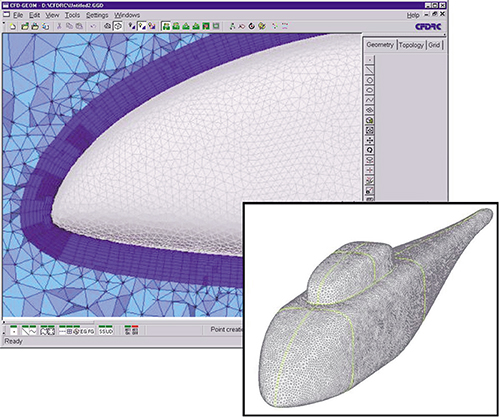Complicated Geometry
With the ever-increasing advancement of computer technology comes the rapidly changing realm of computer modeling software. Whether it's an automobile maker designing a prototype car, a semiconductor manufacturer designing a new wafer, or an aircraft designer developing a new escape system, engineers are on the look-out for advanced computer-aided drawing (CAD) software.
With the help of Small Business Innovation Research (SBIR) funding from NASA's Glenn Research Center, CFD Research Corporation (CFDRC) developed a software package that generates grids for CAD designs. As an extension of CAD, computational fluid dynamics (CFD) is a rapidly growing field that uses cutting-edge methods for designing and understanding the various elements of a wide array of objects, from airplanes and cars to microelectronics. CFD is an invaluable tool for rapid virtual design prototyping and design optimization of semiconductor fabrication equipment and processes.
Within CFD is the relatively new discipline of automated mesh generation. CFD-GEOM, which evolved from the NASA SBIR work, is an advanced, interactive, 3-D modeling and mesh-generation tool used in creating, visualizing, and gridding complex geometries. A mesh represents a surface and/or volume comprised of a network of nodes that connect to form the surfaces, faces, and edges of the modeled object. CFD-GEOM can interface with almost any major commercial CAD program to read geometry information. Depending upon the desired geometry of the grid, the user can create what are known as structured, unstructured, or hybrid meshes. These extremely complex meshes can be used to best simulate the surfaces of a variety of objects.
CFD-GEOM's modeling enables quick and easy updating and editing of the grid in response to changes in the CAD model. CFD-GEOM is designed for fast and intuitive performance, whether the user is designing from scratch or importing data from another CAD package. Easy manipulations include rotation, scaling, and copying. CFD-GEOM is available as a stand-alone package, as well as an integrated part of CFDRC's CFD-ACE+ flow solver package. CFD-ACE+ is used to perform multi-disciplinary analysis on the geometries and grids created by CFD-GEOM.
Along with some of its other software packages, CFDRC is using CFD-GEOM to develop aircraft escape system analysis. When first designing an escape system, the user must make a model from the original CAD surfaces supplied by the seat manufacturer. CAD models are directly imported from another software platform into CFD-GEOM, which then filters the models to produce a baseline aerodynamic structure. The next step involves developing a grid to represent the structure.
CFDRC conducts research and development projects and provides engineering services and software for multidisciplinary designs. The company's core modeling expertise encompasses fluid flow, heat transfer, chemical kinetics, fluid-structure interaction, electrostatics, geometry modeling and grid generation, and scientific visualization. CFDRC technology is used in conventional engineering disciplines, such as aerospace, mechanical, automotive, and chemical engineering, as well as in the new areas of semiconductor materials processing, microelectronics, optoelectronics packaging, nanoelectronics, micro-electromechanical systems (MEMS), and biomedical engineering.

CFD Research Corporation's CFD-GEOM is a 3-D mesh-generation tool.













